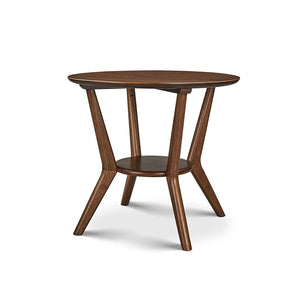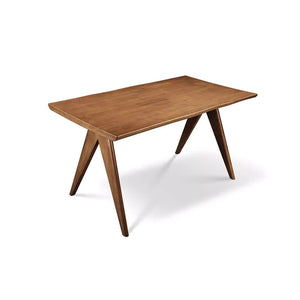Choosing a dining table can feel deceptively tricky. Do you favour the cosy café atmosphere of a round table or the generous surface of a rectangular design, ideal for festive family gatherings?
Let’s break it down with a warm cuppa and plain good advice—plus a bonus bit on how to pick the right size table for your space.
🍽️ Round Dining Tables: Friendly, Flexible and Space-Savvy
There is something wonderfully inviting about a round wooden dining table. With no sharp corners or head-of-the-table, it encourages relaxed meals and effortless conversation.
✅ Pros
-
Space-efficient: Tucks neatly into corners or open-plan rooms, perfect for smaller spaces.
-
Conversation-friendly: Every guest faces one another, making meals feel more personal.
-
Child-safe: No corners to bump into, ideal for households with little ones.
❌ Cons
-
Limited seating: May not accommodate large families or regular dinner parties.
-
Reach challenges: Larger tables can make it difficult to pass dishes or reach the centre.
🪑 Best for: cosy nooks, compact flats and anyone who values an informal dining atmosphere.
🍴 Rectangular Dining Tables: Practical, Classic and Roomy
If you’ve got a bit more space to play with, a rectangular dining table is a classic crowd-pleaser. It’s structured, balanced, and gives everyone a good bit of elbow room.
✅ Pros
-
Ample seating: Seats more guests comfortably, ideal for family gatherings, Sunday roast dinners or midweek get-togethers.
-
Space-efficient in long rooms: Fits neatly into elongated or rectangular dining areas, making the most of available floor space.
-
Generous tabletop: Provides plenty of room for serving dishes, laptops or children’s craft projects without feeling crowded.
❌ Cons
-
Requires more space: Can dominate smaller rooms, leaving less room for circulation.
-
Less intimate: Its formality may not suit laid-back dinners or cosy, conversational layouts.
🪑 Best for: family homes, regular entertainers and longer dining rooms that can accommodate a larger table.
📏 How to Choose the Right Dining Table Size
It’s not just about shape—size matters, too. Here’s how to find your Goldilocks fit:
1. Measure Your Dining Area
Start by measuring the full dining area (length and width), then subtract at least 90cm (about 3 feet) from each side. That gives you comfy space for chairs and easy movement.
2. Allow for Seating Space
Each diner needs roughly 60cm of table width for comfortable eating (and gesturing wildly over pudding).
|
Number of Seats |
Ideal Table Width |
|
2–4 people |
80–120cm |
|
4–6 people |
120–160cm |
|
6–8 people |
160–200cm+ |
Round tables follow a similar logic, but remember: the larger the diameter, the more reach required. Consider a lazy Susan for bigger round tables—it’s not just for Chinese restaurants!.
3. Consider Extendable Options
If you regularly entertain but prefer a compact table day to day, an extendable design offers the best of both worlds. You retain floor space for everyday use and gain extra surface area when guests arrive.
🏡 Which Table Shape is Right for You?
Ask yourself:
-
How many people do I usually host?
-
How large is my dining room?
-
Do I prefer a cosy or grand atmosphere?
Choose round for smaller spaces and intimate meals. Opt for rectangular if you have room to spare and love to entertain a crowd.
🧠 Final Word
Whether you seek a snug round table for a London flat or a spacious rectangular design for a countryside home, the key is opting for a shape and size that suit both your space and lifestyle. Whatever you choose, the true magic lies in who gathers around it.
🤔 🍽️ FAQ 🍽️ 🤔
1. Are round dining tables better for small spaces?
Yes. Their lack of corners and flexible seating make round tables ideal for compact rooms and open-plan apartments.
2. How much clearance is needed around a dining table?
Allow at least 90 cm on all sides to ensure chairs can be pulled out easily and guests can move without obstruction.
3. What diameter table is best for four people?
Aim for a round table with a diameter of around 100 cm to give each diner approximately 60 cm of space.
4. When should I choose an extendable table?
Select an extendable design if you need a smaller table day-to-day but still want to accommodate extra guests on special occasions.
5. Which shape offers the most seating?
Rectangular tables typically seat the most people comfortably and work best in longer dining rooms.










Comments (0)
There are no comments for this article. Be the first one to leave a message!